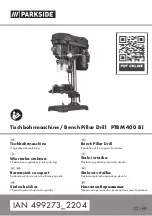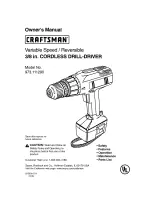
6
SPINDLE SPEEDS
The correct spindle speed depends on the size of the bit and the hardness of the wood. Your best cuts are generally
in the range of 650 to 1800 RPM. Use a slower speed for larger bits and harder woods and faster speeds for smaller
bits and softer woods.
MORTISING CHISEL AND BIT COMBINATIONS
OPERATION
Place the workpiece on the table and adjust the height of the table
so that the point of the chisel clears the work about 1/2". Lower
the chisel along the side of the workpiece to gauge the depth of
the mortise. Adjust the depth stop of the drill press to control the
depth of the mortise. Adjust the guides (X) Fig 21 to hold the work
against the fence (Y), tilting them if necessary. Lower the hold-
down (Z) against the top of the work. This hold-down should hold
the work in place, but should also allow the workpiece to slide to
its next position. These hold-down arms are independently
adjustable. Once you have them adjusted, tighten the thumb
screws (T).
Loosen the locking levers (S) Fig. 21 that hold the mortising
attachment fence to the drill press table. Shift the fence forward
or toward the column to being the workpiece to the desired position under the mortising chisel. Tighten the locking
levers.
Slide the workpiece along the fence to ensure that the cuts will be aligned. Loosen the lock handle (Y) Fig. 21 and turn
the chisel in the holder (if necessary) to make its faces square with the cut. Tighten the lock handle (Y).
NOTE:
If the fence and face of the chisel are not parallel, the cuts will be staggered.
NOTE:
Make mortise cuts to the far left and far right first, then make the cuts in between. This method allows all four
sides of the chisel to make a true vertical cut on each end.
NOTE:
Do not attempt to mortise deeper than maximum depth listed for each chisel as indicated in Fig. 22. Going
past these limits will clog the ejection slots and you will damage the tool or the bit.
NOTE:
Practice on scrap material before you use an actual workpiece.
NOTE:
For through mortises, place a piece of 1/2" plywood between the workpiece and the drill press table to
eliminate splintering.
Z
T
S
S
X
T
T
Fig. 20
Fig. 21
Y
Summary of Contents for 17-935
Page 8: ...8 NOTES...


























